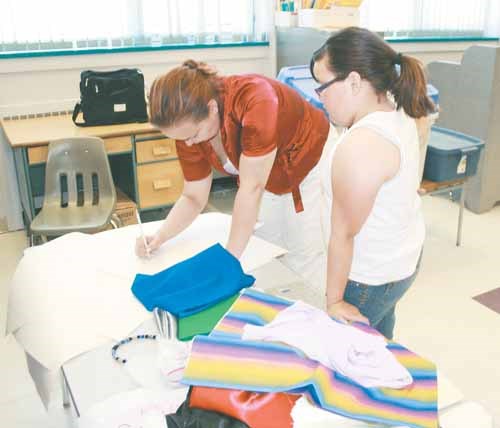The powwow is important to First Nations people and Shanon Crook, the Aboriginal Community Worker at Dr. Brass School is trying to help students connect with that aspect of their culture.
Crook has undertaken to help young students create the dress to wear to partake in the various powwow dance styles.
"I know it's always been the idea of having something like this going," she said.
So Crook began to put a group of students interested in not just creating the costumes, but also beginning to learn the dances.
"I just started (in her position) in February," said Crook, adding she "started putting the group together," almost immediately. There are 15-to-20 students taking part.
The students involved are a cross section of Grades 4 to 8, "so they help as much as they can," said Crook, adding "I work with some of the moms too."
The first step for students was determining what style of dance interests them, said Crook.Girls could choose from jingle, fancy shawl or traditional, while boys have grass, traditional, chicken and fancy bustle.
Crook said the range of interest and knowledge among the students was quite significant."I knew some of the students had probably grown up with this ever since they were little," she said.
In other cases, the group was really the student's first introduction to powwow.
For those just learning, Crook said she had to include teaching the rules and protocol associated with the dancing.
In some cases students have danced powwow before, and they have been able to help those with no experience.
"We're trying to learn from each other," said Crook.
Crook herself has danced in the past.
"To begin with I made a fancy shawl, and after that I got into jingle dress," she said. " I've danced at powwows but never competitively."
More recently she was taught by champion Boye Ladd at the Centre For Indigenous People at Wahepton near Prince Albert.
And, she said she has also turned to technology for help in teaching the different styles."There are hundreds of videos, even just on Youtube," she said, adding they view the video and focus on learning the different moves.
Once the students had picked a dance style, Crook said they could start putting their traditional costumes together, starting with "what colours they wanted."
Crook said colour can have significant meaning to some.
"Some wanted colours that were given to them when they were given their Indian name," she said, adding for others it was choice made "just because they liked them."
Crook said she simply tried to guide decisions, not make them.
"I asked them as much as I could because it's theirs. It's for them," she said.In terms of creating the costumes, Crook said, "I never bought any patterns I had to make patterns for each of the girls' dresses," working off individual measurements. She said Margaret Brass has been a big help in doing the work too.
Crook said as interest grew, stretching dollars became important in regards to finding materials and enhancements for the costumes.
In some cases it has been a major problem. For example, the men's bustles require eagle feathers, not something easily found, she said.
In other cases it has proven a case of 小蓝视频 creative, said Crook, noting table cloths have proven excellent shawls.
Crook said she hopes the costumes are ready, and the basic moves of the dances learned so the students can participate in National Aboriginal Day activities in the city in June, and potentially at the annual powwow held in the city.
"I hope we can be part of the Grand Entry at the powwow," she said.




